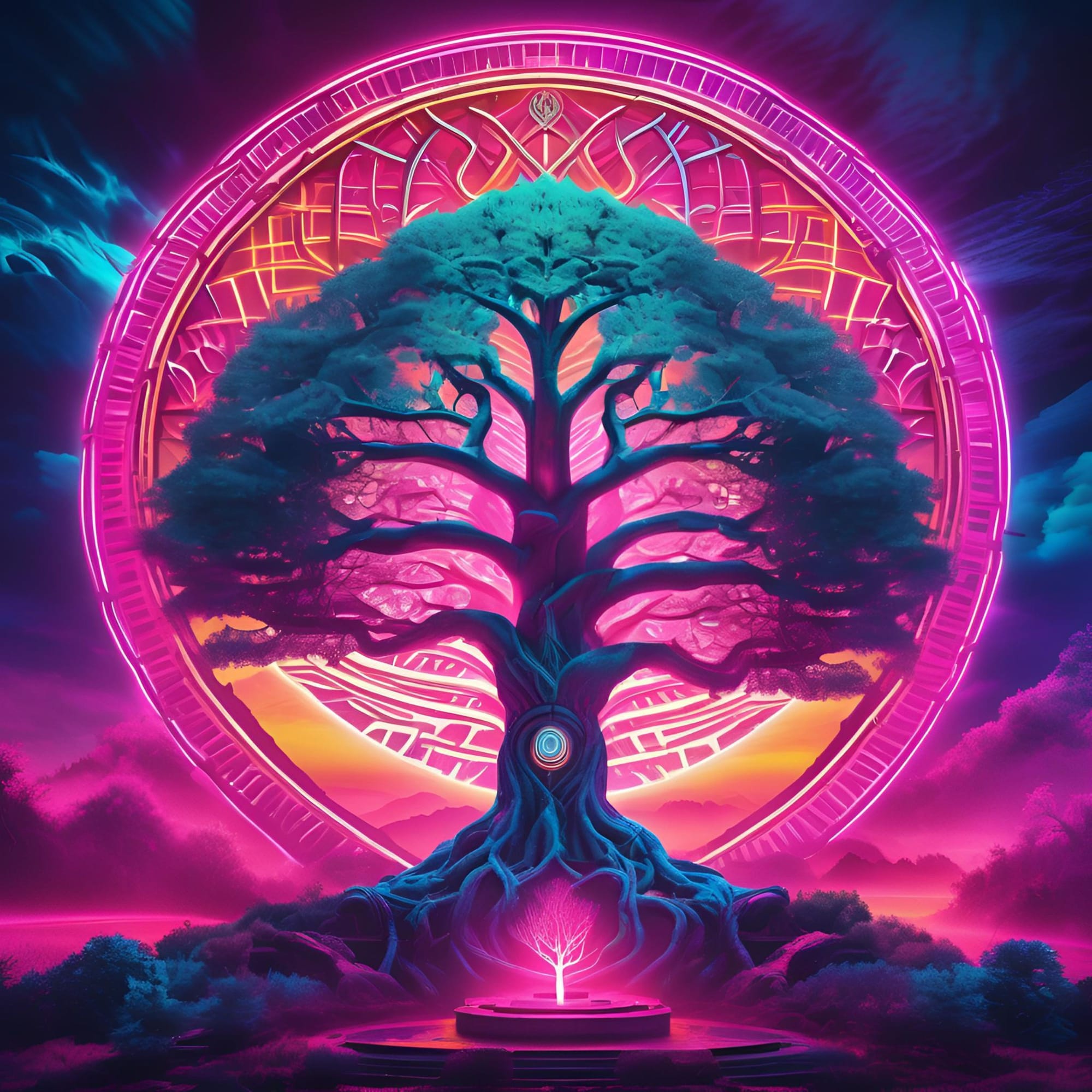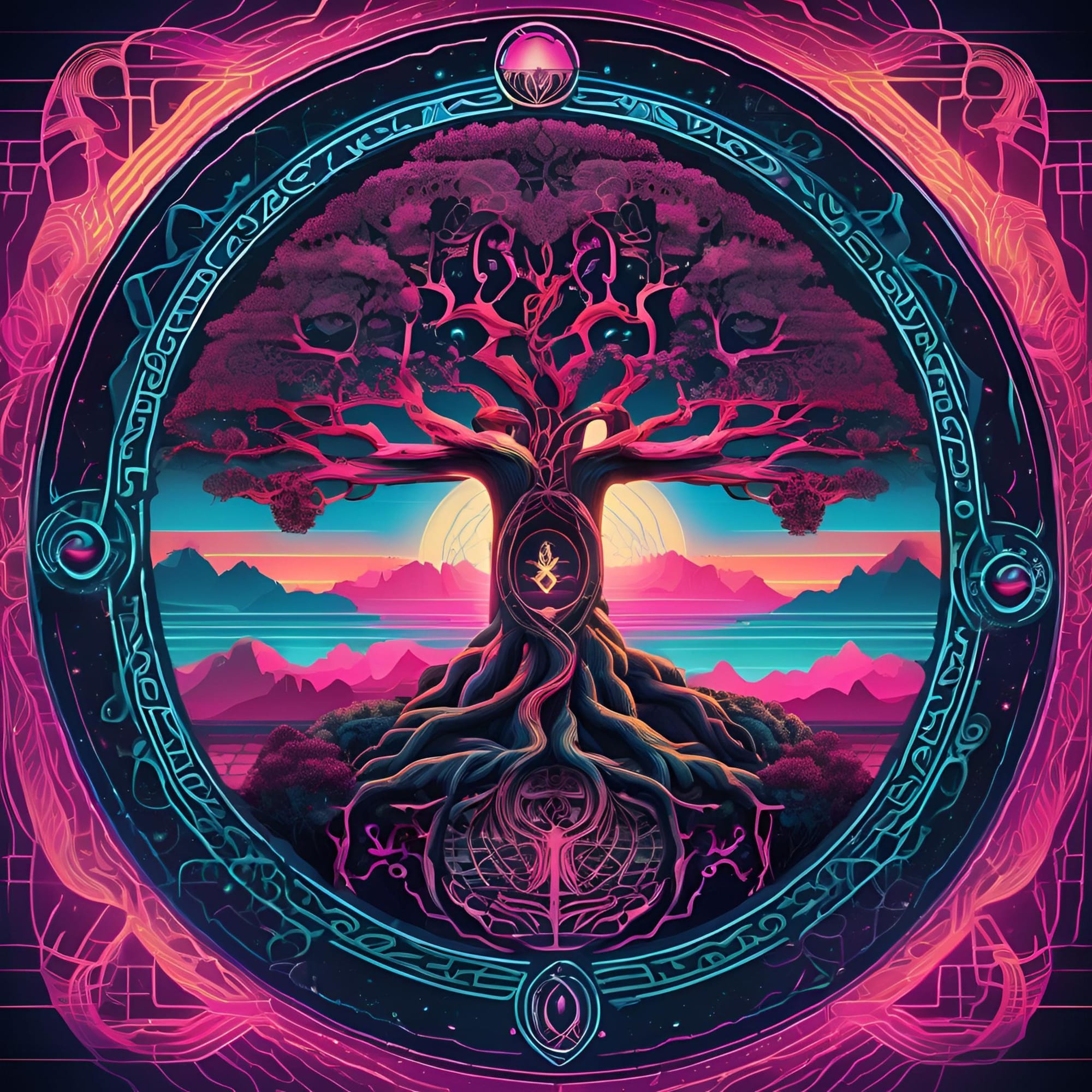








buymeacoffee.com coming soon..
Introduction to Yggdrasil
Yggdrasil, often known as the World Tree, stands as a central symbol in Norse mythology, embodying the interconnectedness of all life and the cosmos. This immense ash tree is more than just a physical entity; it represents creation, existence, and the cyclical nature of life and death. As the *axis mundi*, or world axis, Yggdrasil connects the heavens, the earth, and the underworld, serving as a bridge between the various realms that comprise the Norse universe.
The origins of Yggdrasil can be traced back to ancient Norse beliefs, where it was revered as a sacred entity. Its roots delve deep into the underworld, while its branches stretch high into the heavens, symbolizing the duality of existence. In Norse cosmology, Yggdrasil plays a pivotal role in maintaining the balance of the universe, representing the life force that binds together all beings and realms.
In the vast landscape of Norse mythology, Yggdrasil serves as the hub around which the nine realms revolve. Each of these realms, including Asgard, Midgard, and Hel, is intricately linked to the tree, highlighting the concept that all life is interconnected. Yggdrasil is not merely a backdrop for the myths; it actively participates in the unfolding of events within the Norse pantheon, influencing gods and mortals alike. Through its presence, Yggdrasil encapsulates the essence of life, death, and rebirth, making it a timeless symbol that resonates through centuries and cultures.
The Structure of Yggdrasil
Description of Yggdrasil’s Branches and Roots
Yggdrasil, often described as an immense ash tree, serves as the cosmic axis connecting various realms within Norse cosmology. Its towering branches stretch high into the heavens, while its roots dig deep into the earth, symbolizing the interconnectedness of all existence. The tree's bark is rugged and sturdy, representing resilience and strength amid the universe's trials.
The branches of Yggdrasil are not just physical extensions; they symbolize pathways linking different realms of existence. As they intertwine and spread out, they create a canopy that shelters the gods, spirits, and various beings inhabiting the nine realms. Each branch serves as a conduit for the life force flowing through the universe, reflecting the belief that life is a continuous cycle of birth, death, and rebirth.
Conversely, the roots of Yggdrasil extend into three primary wells: Urðr, Mimir, and Hvergelmir. Each of these wells holds its own magical properties and significance. For instance, the well of Urðr is associated with fate and serves as the gathering place for the Norns—female beings who control destiny—where they weave the threads of life. This intricate structure exemplifies how Yggdrasil embodies the balance between celestial and terrestrial realms.
The Nine Realms Connected by Yggdrasil
Yggdrasil serves as the central pillar connecting the nine realms of Norse mythology, each representing different aspects of existence. These realms include:
1. Asgard: The realm of the Aesir gods, including Odin and Thor, characterized by majestic palaces and divine beings.
2. Vanaheim: Home to the Vanir gods, associated with fertility, prosperity, and nature.
3. Alfheim: The land of light elves, depicted as ethereal beings of beauty and grace.
4. Midgard: The realm of humans, situated in the cosmos's center and connected to Asgard by the Bifrost, a rainbow bridge.
5. Jotunheim: The land of giants, known for its rugged terrain and formidable inhabitants often opposing the gods.
6. Niflheim: A realm of ice and mist, associated with cold, darkness, and the dead.
7. Muspelheim: The fiery realm of fire giants, representing heat and chaos, playing a crucial role in creation myths.
8. Helheim: The realm of the dead ruled by Hel, where those who did not die a heroic death reside.
9. Svartalfheim: Home of the dark elves, or dwarves, known for their craftsmanship and metalwork skills.
Each of these realms is intricately linked by Yggdrasil, illustrating the interconnectedness of all beings and phenomena in the Norse cosmos. The tree not only supports the universe's structure but also signifies the relationships and interactions between various realms, emphasizing that every entity—divine, human, or monstrous—plays a vital role in the cosmic order.
Symbolism of the Tree in Norse Culture
In Norse culture, Yggdrasil transcends its role as a physical structure; it symbolizes life, death, and the interconnectedness of all beings. The tree embodies growth and renewal, mirroring the natural cycles of the seasons and the perpetual flow of life. Its roots and branches encapsulate the duality of existence—life and death, order and chaos, the known and the unknown.
Yggdrasil also serves as a reminder of the significance of balance and harmony. Just as the tree supports various realms and creatures, it highlights the need for equilibrium within the universe. The health of Yggdrasil is believed to reflect the cosmos's state; if the tree were to wither, it would signal chaos and destruction within the realms.
Moreover, Yggdrasil vividly represents the concept of fate in Norse mythology. The Norns, residing at the tree's base, weave the destinies of gods and men alike, signifying that while individuals have agency, their lives intertwine with greater cosmic forces. This notion of fate and interconnectedness resonates deeply within Norse culture, shaping their understanding of existence and the natural world.
In summary, Yggdrasil's structure is not merely a physical representation of a tree but a profound symbol of life, interconnectedness, and the intricate balance of the cosmos that permeates Norse mythology and culture.
Creatures Associated with Yggdrasil
Yggdrasil, the great Tree of Life, is not only a central figure in Norse mythology but also a habitat for various creatures that embody the complexities of the cosmos and its intertwined fates. These beings, each with their unique traits and stories, offer insights into the nature of existence and the interconnectedness of all things within the Norse worldview.
The Serpent Níðhöggr and Its Role
One of the most notable creatures associated with Yggdrasil is Níðhöggr, a menacing serpent residing at the tree's base. Níðhöggr is often depicted gnawing at Yggdrasil's roots, symbolizing decay and destruction. This serpent represents the darker aspects of existence, including chaos and the inevitability of death. Its perpetual gnawing serves as a reminder that even the mightiest trees, like Yggdrasil, must contend with forces seeking to undermine them. Níðhöggr is also linked to the idea of rebirth, as its actions may lead to the regeneration of life, emphasizing the cyclical nature of the universe in Norse thought.
The Eagle Perched atop Yggdrasil
At the top of Yggdrasil sits a wise and majestic eagle, often seen as a symbol of knowledge and foresight. This eagle, whose name varies in different texts, embodies the lofty aspirations of the gods and the pursuit of wisdom. It is believed that the eagle has a clear view of the entire cosmos, representing the overarching perspective gained through understanding and enlightenment. The eagle’s presence atop Yggdrasil highlights the theme of equilibrium in Norse mythology, illustrating that wisdom must be balanced with the knowledge of life's challenges, including those posed by creatures like Níðhöggr.
The Squirrel Ratatoskr and Its Significance
Another significant creature in the Yggdrasil mythos is Ratatoskr, a squirrel tasked with carrying messages between the eagle at the top of the tree and Níðhöggr at its roots. Ratatoskr is often viewed as a trickster figure, darting up and down the tree while spreading gossip and tales, sometimes exacerbating tensions between the eagle and the serpent. His actions symbolize the flow of communication and the often chaotic nature of information exchange. Ratatoskr's role as a messenger reflects the interconnectedness of all realms and beings in Norse mythology, reminding us that the stories we share can influence our relationships and the balance of power in the cosmos.
In summary, the creatures associated with Yggdrasil not only enrich the mythology surrounding this sacred tree but also illustrate the complex dynamics of life, death, wisdom, and communication. Each being plays a vital role in the narrative of existence, contributing to the broader themes of interconnectedness and balance central to Norse cosmology. Through these figures, we gain a deeper understanding of the rich tapestry of life woven into the very fabric of Yggdrasil.
Conclusion: The Legacy of Yggdrasil
Yggdrasil’s Influence on Modern Culture
The legacy of Yggdrasil extends far beyond ancient texts, permeating various facets of modern culture. From literature to film and video games, the concept of a world tree or a central life force continues to resonate with contemporary audiences. Works inspired by Norse mythology often reference Yggdrasil as a symbol of connection and harmony among disparate realms, reflecting humanity's enduring fascination with the cosmos and the interconnectedness of life. Movies like "Thor" and the "Marvel Cinematic Universe" have brought Yggdrasil into mainstream consciousness, showcasing its significance while introducing a new generation to the depth of Norse mythology.
The Enduring Symbolism of the Tree
Yggdrasil serves as a powerful symbol of life, growth, and the cyclical nature of existence. Its roots, stretching deep into the earth, represent the foundation of knowledge and wisdom, while its branches reach towards the heavens, signifying aspiration and the quest for enlightenment. This duality captures the essence of human experience—the balance between the earthly and the divine. In various spiritual and philosophical frameworks, Yggdrasil has come to embody the idea of unity and the interplay between life and death, growth and decay, making it a profound symbol that transcends cultures and epochs.
Final Thoughts on the Importance of Yggdrasil
In conclusion, Yggdrasil is not merely an ancient mythological construct; it is a timeless emblem of the interconnectedness of all existence. Its depiction in Norse mythology reflects the cultural values and beliefs of the time, while its ongoing relevance in modern interpretations highlights the universal themes of life, death, and rebirth. As we navigate the complexities of our own lives, the imagery of Yggdrasil reminds us of the roots that ground us and the aspirations that elevate us. Ultimately, Yggdrasil continues to inspire and challenge us to recognize the threads that bind us to each other and the cosmos, ensuring its legacy endures for generations to come.





